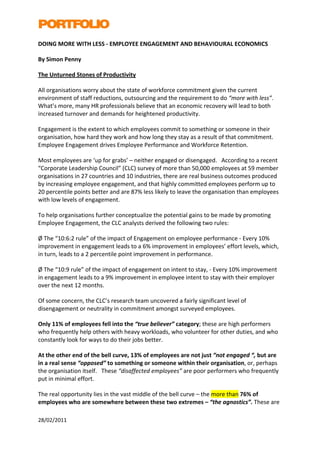More Related Content
More from Simon Penny (20)
Doing More With Less Employee Engagement And Behavioural Economics
- 1.
DOING MORE WITH LESS ‐ EMPLOYEE ENGAGEMENT AND BEHAVIOURAL ECONOMICS
By Simon Penny
The Unturned Stones of Productivity
All organisations worry about the state of workforce commitment given the current
environment of staff reductions, outsourcing and the requirement to do “more with less”.
What’s more, many HR professionals believe that an economic recovery will lead to both
increased turnover and demands for heightened productivity.
Engagement is the extent to which employees commit to something or someone in their
organisation, how hard they work and how long they stay as a result of that commitment.
Employee Engagement drives Employee Performance and Workforce Retention.
Most employees are ‘up for grabs’ – neither engaged or disengaged. According to a recent
“Corporate Leadership Council” (CLC) survey of more than 50,000 employees at 59 member
organisations in 27 countries and 10 industries, there are real business outcomes produced
by increasing employee engagement, and that highly committed employees perform up to
20 percentile points better and are 87% less likely to leave the organisation than employees
with low levels of engagement.
To help organisations further conceptualize the potential gains to be made by promoting
Employee Engagement, the CLC analysts derived the following two rules:
Ø The “10:6:2 rule” of the impact of Engagement on employee performance ‐ Every 10%
improvement in engagement leads to a 6% improvement in employees’ effort levels, which,
in turn, leads to a 2 percentile point improvement in performance.
Ø The “10:9 rule” of the impact of engagement on intent to stay, ‐ Every 10% improvement
in engagement leads to a 9% improvement in employee intent to stay with their employer
over the next 12 months.
Of some concern, the CLC’s research team uncovered a fairly significant level of
disengagement or neutrality in commitment amongst surveyed employees.
Only 11% of employees fell into the “true believer” category; these are high performers
who frequently help others with heavy workloads, who volunteer for other duties, and who
constantly look for ways to do their jobs better.
At the other end of the bell curve, 13% of employees are not just “not engaged “, but are
in a real sense “opposed” to something or someone within their organisation, or, perhaps
the organisation itself. These “disaffected employees” are poor performers who frequently
put in minimal effort.
The real opportunity lies in the vast middle of the bell curve – the more than 76% of
employees who are somewhere between these two extremes – “the agnostics”. These are
28/02/2011
- 2.
employees who do not go to great lengths in their jobs, but neither do they shirk their work.
This group is therefore “up for grabs” – they may not yet have found reasons to fully commit
to their organisations, but they may well be willing to commit to their company more deeply
given the right incentives. Research also indicates that most employees need the same
things to commit to their company, exert effort and perform at their best.
One of the top engagement drivers in fostering Employee Engagement, and by extension
employee effort and retention, is the role of the local manager.
Managers can strongly impact employee discretionary effort and retention by focusing on
the three C’s:
Ø Connection ‐ Ensuring that employees understand Organisational Goals, the connection of
their jobs to Organisational Strategy, and the importance of their jobs to Organisational
Success.
Ø Contribution ‐ Refining their people and process management skills by being adaptable,
setting realistic performance expectations, and helping employees to find solutions to
problems at work and to break down projects into manageable components.
Ø Credibility ‐exhibiting the qualities of honesty, integrity, and a commitment to diversity.
Employees who are highly engaged perform better on the job and offer better customer
service, leading to higher business profits as a result of that service. A Gallup study of
Employee Engagement at call centers found that the more engaged the employees were, the
more satisfied customers were – and the more satisfied customers were the less customer
attrition. According to the study, a 5% to 10% increase in employee engagement at call
centers resulted in an increase of 1,227 to 2,454 more calls per year. Since researchers
found that customer satisfaction is directly related to the number of calls needed to resolve
a query, the extra minutes’ would contribute to fewer average calls per query resolution
and, thus, less customer attritions.
If 76% of employees are neither fully committed nor uncommitted and we know that
managers are the conduit to what matters (connection, contribution and credibility) the
challenge is to engage “the agnostics” who are “up for grabs” ‐ enticing them to become
“true believers".
According to the Gallup Organisation's new applied behavioral economics approach the
discipline of Employee Engagement commences by embracing human nature, as we are all
human beings before we are employees. By capitalizing on basic human nature to select
and position employees, to manage and motive them, to accelerate their development and
unleash both their innovation and productivity, Managers hold the keys to ultimately engage
the emotions of a company’s most important asset – their customers.
28/02/2011

